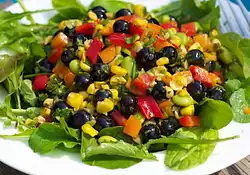Blueberries
About the ingredient blueberries. Including 461 recipes with blueberries, nutrition data, photos, and where to find it.

Contents
What are blueberries?
Blueberries are a berry, ranging from 5–16 millimetres (0.20–0.63 in) diameter with a flared crown at the end; they are pale greenish at first, then reddish-purple, and finally indigo blue when ripe.
They have a sweet taste when mature, with variable acidity. Blueberry bushes typically bear fruit in the middle of the growing season: fruiting times are affected by local conditions such as altitude and latitude, so the height of the crop can vary from May to August depending upon these conditions.
Blueberries are sold fresh or processed as individually quick frozen (IQF) fruit, purée, juice, or dried or infused berries which in turn may be used in a variety of consumer goods such as jellies, jams, blueberry pies, muffins, snack foods, and cereals.
Blueberries have a diverse range of micronutrients, with notably high levels (relative to respective Dietary Reference Intakes) of the essential dietary mineral manganese, vitamin B6, vitamin C, vitamin K and dietary fiber (table).
One serving provides a relatively low glycemic load score of 4 out of 100 per day.
Especially in wild species, blueberries contain anthocyanins, other antioxidant pigments and various phytochemicals possibly having a role in reducing risks of some diseases, including inflammation and certain cancers.
Nutrition
Nutrition Facts
Serving Size 1 cup (148g)Where found
Blueberries are usually found in the produce section or aisle of the grocery store or supermarket.
Food group
Blueberries are a member of the Fruits and Fruit Juices US Department of Agriculture nutritional food group.
How much do blueberries weigh?
| Amount | Weight |
|---|---|
| 1 cup | 148 grams |
| 1 pint as purchased, yields | 402 grams |
| 50 berries | 68 grams |
Related
Fruits and Fruit Juices
| In Chinese: | 蓝莓 | |
| British (UK) term: | ||
| en français: | la myrtilles | |
| en español: | el arándanos |
Recipes using blueberries
There are 461 recipes that contain this ingredient.

Granola with Fresh Fruit
Nice and convenient breakfast for kids.

Buttermilk Waffles
Buttermilk Waffles recipe

Buttery Blueberry Banana Muffins
Blueberry Banana Muffins recipe

Uncle's Favorite Blueberry Muffins
Uncle's Favorite Blueberry Muffins recipe

Blueberry Muffins with Nutmeg Topping
Blueberry Muffins with Nutmeg Topping recipe

Blueberry Orange Muffins
Blueberry Orange Muffins recipe

Jordan's Blueberry Muffins
Jordan's Blueberry Muffins recipe

Muffins, Blueberry
Muffins, Blueberry recipe

Yummy Blueberry Buttermilk Muffins
Blueberry Buttermilk Muffins recipe

Super Blueberry Muffins
Mom's Blueberry Muffins recipe

Favorite Blueberry Pancakes
Favorite Blueberry Pancakes recipe

Double Berry Muffins
Double Berry Muffins recipe

Buttermilk Pancakes with Blueberry Sauce
Buttermilk Pancakes with Blueberry Sauce recipe

Fluffy Blueberry Buttermilk Pancakes
These flapjacks are leaps and bounds better than any other I've tested. The key is the buttermilk which makes them thick and fluffy and adds just the right flavor.

Blueberry Hill Muffins
From a new blueberry cookbook I just got, these sound good for my two blueberry lovin' guys! I like that they have very little butter in them...cant wait to try them out! It doesnt say how many it makes so Im guessing at 6.

Spicy Blueberry Citrus Marmalade
Spicy Blueberry Citrus Marmalade recipe

Morning Blueberry Orange Muffins
Blueberry Orange Muffins recipe

Blueberry, Roasted Corn, Soy Bean & Arugula Salad
Fresh blueberries, roasted sweet corn, soy bean, red bell pepper and peppery arugula are tossed with a white wine vinegar-olive oil vinaigrette. It's a light and tasty summer salad that accompanies well with any barbecued dishes.

Blueberry Jam
Blueberry Jam recipe











